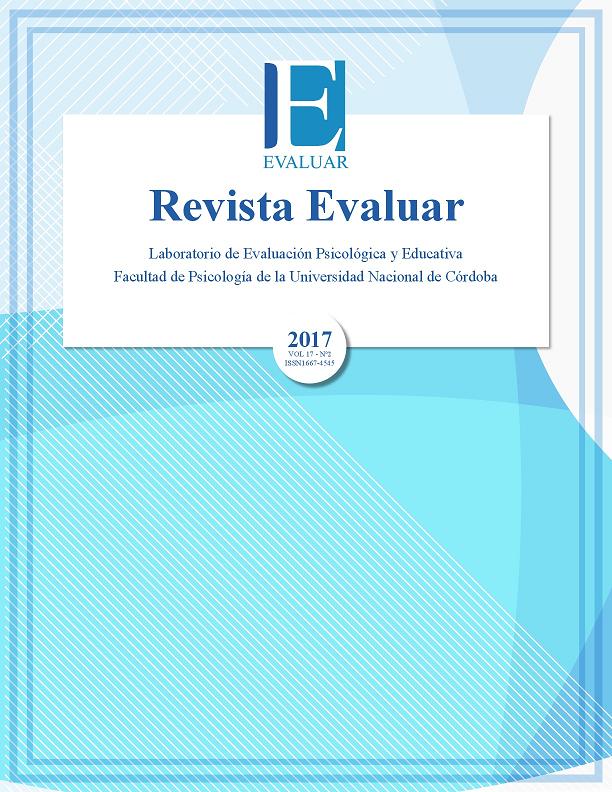Psychometric properties of the Posttraumatic Growth Inventory (PTGI) in Ecuadorian population
DOI:
https://doi.org/10.35670/1667-4545.v17.n2.18722Keywords:
psicología positiva, análisis factorial confirmatorio, desastre natural, terremotoAbstract
In the study of human behavior concerning the ex-position to highly stressful events, psychology has taken a leap forward, studying not only the negative effects of such events, but also the knowledge a person may gain from them, which is known as posttraumatic growth. The aim of this study was to analyze the psychometric properties of the Posttraumatic Growth Inventory (PTGI) in a sample of 450 adult survivors of the earthquake that took place on the Ecuadorian coast in 2016. The PTGI showed high internal consistency (α = .95). The confirmatory factor analysis dis-played an appropriate adjustment for a bifactor structure consisting of three specific factors and one general factor. Furthermore, the PTGI showed a factorial invariance when comparing men and women. We could conclude that the PTGI is a reliable and internally valid instrument for the study of posttraumatic growth in Ecuadorian population.Downloads
References
American Psychiatric Association (2013). Manual Diagnóstico y Estadístico los Trastornos Mentales DSM-V. Barcelona, España: Masson.
Anderson Jr, W. P., & Lopez-Baez, S. I. (2008). Measuring growth with the Posttraumatic Growth Inventory. Measurement and Evaluation in Counseling and Development, 40(4), 215-227.
Arbuckle, J. L. (2009). Amos (Version 20.0) [Computer Program]. Chicago, IL: IBM SPSS.
Avilés-Maldonado, P., Cova-Solar, F., Bustos, C., & García, F. E. (2014). Afrontamiento y rumiación frente a eventos adversos y crecimiento postraumático en estudiantes universitarios. Liberabit, 20(2), 281-292. Recuperado de http://www.scielo.org.pe/pdf/liber/v20n2/a09v20n2.pdf
Bentler, P. (2005). EQS Structural equations program manual. Encino, CA: Multivariate Software.
Bollen, K. A. (1989). Structural equations with latent variables. New York, NY: John Wiley & Sons. doi: 10.1002/9781118619179
Brown, T. A. (2006). Confirmatory Factor Analysis for Applied Research. New York, NY: Guilford Press.
Brunet, J., McDonough, M. H., Hadd, V., Crocker, P. R. E., & Sabiston, C. M. (2010). The Posttraumatic Growth Inventory: An examination of the factor structure and invariance among breast cancer survivors. Psycho-Oncology, 19(8), 830-838. doi: 10.1002/pon.1640
Byrne, B. (2006). Structural equation modeling with Mplus.New York, NY: Routledge.
Calhoun, L. G., Cann, A., & Tedeschi, R. G. (2010). The Posttraumatic Growth Model: Sociocultural considerations. En T. Weiss & R. Berger (Eds.), Posttraumatic growth and culturally competent practice: Lessons learned from around the globe (pp.1-14). New York, NY: John Wiley & Sons. doi: 10.1002/9781118270028.ch1
Cheung, G. W., & Rensvold, R. B. (2002). Evaluating goodness-of-fit indexes for testing measurement in-variance. Structural Equation Modeling, 9(2), 233-255. doi: 10.1207/S15328007SEM0902_5
Costa-Requena, G., & Moncayo, F. L. G. (2007). Crecimiento postraumático en pacientes oncológi-cos. Análisis y Modificación de Conducta, 33(148), 229-250. Recuperado de http://uhu.es/publicaciones/ojs/index.php/amc/article/view/1215
Elosúa, P. (2005). Evaluación progresiva de la invarianza factorial entre las versiones original y adaptada de una escala de autoconcepto. Psicothema, 17(2), 356-362. Recuperado de: http://www.ehu.eus/gip/publicaciones/articulos/2005/2.pdf
Esparza-Baigorria, T., Leibovich de Figueroa, N., & Martínez-Terrer, M. (2016). Propiedades psicomé-tricas del Inventario de Crecimiento Postraumático en pacientes oncológicos en población argentina. Ansiedad y Estrés 22(2) 97-103. doi: 10.1016/j.anyes.2016.06.002
García, F. E., Capponi, C., Hinrichs, F., Lillo, F., Rodríguez, C., & Sánchez, J. (2016). Violencia policial y afrontamiento: Crecimiento postraumático en pobladores de una comunidad aislada del sur de Chile. Universitas Psychologica, 15(4). doi: 10.11144/Javeriana.upsy15-4.vpac
García, F. E., Cova-Solar, F., & Melipillán, R. (2013). Propiedades psicométricas del Inventario de Crecimiento Postraumático en población Chilena afectada por un desastre natural. Revista Mexicana de Psicología, 30(2), 143-151. Recuperado de http://www.redalyc.org/articulo.oa?id=243033029007http://www.redalyc.org/articulo.oa?id=243033029007
García, F. E., Cova, F., Rincón, P., Vázquez, C., & Páez, D. (2016). Coping, rumination and posttraumatic growth in people affected by an earthquake. Psicothema, 28(1), 59-65. doi: 10.7334/psicothema2015.100
García, F. E., Jaramillo, C., Martínez, A. M., Valenzuela, I., & Cova-Solar, F. (2014). Respuestas psicológicas ante un desastre natural: Estrés y crecimiento postraumático. Liberabit, 20, 121-130. Recuperado de http://www.scielo.org.pe/pdf/liber/v20n1/a11v20n1.pdf
García, F. E., Páez, D., Reyes-Reyes, A., & Álvarez, R. (2017). Religious coping as moderator of psychological responses to stressful events: A longitudinal study. Religions, 8(62), 1-13. doi: 10.3390/rel8040062
García, F. E., Páez-Rovira, D., Zurtia, G. C., Martel, H. N, & Reyes, A. R. (2014). Religious coping, social support and subjective severity as predictors of posttraumatic growth in people affected by the earthquake in Chile on 27/2/2010. Religions, 5(4), 1132-1145. doi: 10.3390/rel5041132
Garcia da Silva, T., Candia-Donat, J., Gauer, G., & Haag-Kristensen, C. (2016). Posttraumatic growth measures: Translation and adaptation of three self-report instruments to Brazilian Portuguese. Archives of Clinical Psychiatry (Sao Paulo), 43(3), 47-50. doi: 10.1590/0101-60830000000083
Garrido-Hernansaiz, H., Rodríguez-Rey, R., & Alonso-Tapia, J. (2017). Posttraumatic Growth Inventory: Factor structure in Spanish-speaking people living with HIV. AIDS Care, 1-4. doi: 10.1080/09540121.2017.1291900
Hooper, L. M., Marotta, S. A., & Depuy, V. (2009). A confirmatory factor analytic study of the Posttraumatic Growth Inventory among a sample of racially diverse college students. Journal of Mental Health, 18(4), 335-343. doi: 10.1080/09638230802522502
IBM Corp (2011). IBM SPSS Statistics for Windows, Version 21.0. Armonk, NY: IBM Corp.
Joseph, S., & Linley, P. A. (2008). Psychological assessment of growth following adversity: A review. En S. Joseph & P. Linley (Eds.), Trauma, recovery, and growth: Positive psychological perspectives on pos-ttraumatic stress (pp. 21-38). New York, NY: John Wiley & Sons. doi: 10.1002/9781118269718.ch2
Joseph, S., Linley, P. A., & Harris, G. J. (2004). Understanding positive change following trauma and adversity: A structural clarification. Journal of Loss and Trauma, 10(1), 83-96. doi: 10.1080/15325020490890741
Kline, R. B. (2005). Principles and practice of structural equation modeling (3th ed.). New York, NY: Guilford.
Konkolÿ-Thege, B., Kovács, É., & Balog, P. (2014). A bi-factor model of the Posttraumatic Growth Inventory. Health Psychology and Behavioral Medicine: An Open Access Journal, 2(1), 529-540. doi: 10.1080/21642850.2014.905208
Mardia, K. V. (1970). Measures of multivariate skewness and kurtosis with applications. Biometrika, 57(3), 519-530. doi: 10.2307/2334770
Mardia, K. V. (1974). Applications of some measures of multivariate skewness and kurtosis in testing nor-mality and robustness studies. Sankhya: The Indian Journal of Statistic, 36(2), 115-128. Recuperado de http://www.jstor.org/stable/25051892
Martínez-Arias, R. (1995). Psicometría: teoría de los test psicológicos y educativos. Madrid, España: Síntesis.
Palmer, G. A., Graca, J. J., & Occhietti, K. E. (2012). Confirmatory factor analysis of the Posttraumatic Growth Inventory in a veteran sample with posttraumatic stress disorder. Journal of Loss and Trauma, 17(6), 545-556. doi: 10.1080/15325024.2012.678779
Powell, S., Rosner, R., Butollo, W., Tedeschi, R. G., & Calhoun, L. G. (2003). Posttraumatic growth after war: A study with former refugees and displaced people in Sarajevo. Journal of Clinical Psychology, 59(1), 71-83. doi: 10.1002/jclp.10117
Rodríguez-Rey, R., Alonso-Tapia, J., Kassam-Adams, N., & Garrido-Hernansaiz, H. (2016). The factor structure of the Posttraumatic Growth Inventory in parents of critically ill children. Psicothema, 28(4), 495-503. doi: 10.7334/psicothema2016.162
Rodríguez-Ayán, M. N., & Ruiz Diaz, M. Á. (2008). Atenuación de la asimetría y de la curtosis de las puntuaciones observadas mediante transformaciones de variables: Incidencia sobre la estructura factorial. Psicológica: Revista de Metodología y Psicología Experimental, 29(2), 205-228. Recuperado de http://www.uv.es/revispsi/articulos2.08/6RODRIGUEZ.pdf
Taku, K., Cann, A., Calhoun, L. G., & Tedeschi, R. G. (2008). The factor structure of the Posttraumatic Growth Inventory: A comparison of five models using confirmatory factor analysis. Journal of Traumatic Stress, 21(2), 158-164. doi: 10.1002/jts.20305
Tedeschi, R. G., & Calhoun, L. G. (1996). The Posttraumatic Growth Inventory: Measuring the positive legacy of trauma. Journal of Traumatic Stress, 9(3), 455-471. doi: 10.1002/jts.2490090305
Tedeschi, R. G., & Calhoun, L. G. (2000). Posttraumatic growth: A new focus in psycho traumatology. Psy-talk, Newsletter of the British Psychological Society Student Members Group, April 2000.
Tedeschi, R. G., & Calhoun, L. G. (2008). Crecimiento postraumático en las intervenciones clínicas cognitivo-conductuales. En V. Caballo (Ed). Manual para el tratamiento cognitivo-conductual de los trastornos psicológicos (pp. 30-49). Madrid, España: Siglo XXI.
Vishnevsky, T., Cann, A., Calhoun, L. G., Tedeschi, R. G., & Demakis, G. J. (2010). Gender differences in self-reported posttraumatic growth: A meta-analysis. Psychology of Women Quarterly, 34(1), 110-120. doi: 10.1111/j.1471-6402.2009.01546.x
Weiss, T., & Berger, R. (2006). Reliability and validity of a Spanish version of the Posttraumatic Growth Inventory. Research on Social Work Practice, 16(2), 191-199. doi: 10.1177/1049731505281374
Downloads
Published
How to Cite
Issue
Section
License
Copyright (c) 2017 Patricio R. Arias

This work is licensed under a Creative Commons Attribution 4.0 International License.
Revista Evaluar aplica la Licencia Internacional de Atribuciones Comunes Creativas (Creative Commons Attribution License, CCAL). Bajo esta licencia, los autores retienen la propiedad de copyright de los artículos pero permiten que, sin que medie permiso de autor o editor, cualquier persona descargue y distribuya los artículos publicados en Evaluar. La única condición es que siempre y en todos los casos se cite a los autores y a la fuente original de publicación (i.e. Evaluar). El envío de artículos a Evaluar y la lectura de los mismos es totalmente gratuito.




_(3).jpg)



.jpg)



